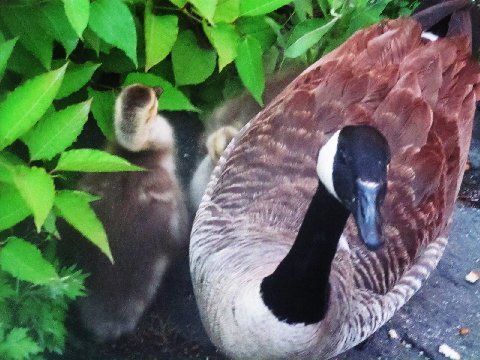Photo by Patty Adjamine
It's the annual summer goose molt, when an estimated 3.2 million non-migratory Canada geese take up residence at the nation's parks, ponds and golf courses, temporarily stranded until new flight feathers grow in.
The skies seem empty, void of the familiar honking and breathtaking fly-overs from June through mid-July. Suddenly there are 75 geese at a lake where there are usually no more than half a dozen. A molt location is a sacred place to geese, a haven where they can rest and feed, free from predators. Some geese travel many miles to reach a favored molt.
The molt can also be an enriching experience for children if parents and grandparents use the presence of large numbers of waterfowl to teach youngsters respect and compassion for those birds that share our communities. It can help children build enduring connections to nature, fostering a sense of stewardship that lasts a lifetime. (Of course, the geese like it too!)
The grounds will be littered with feathers that children collect. I don't know what they do with them but they seem to enjoy collecting them, treating the worn, frazzled feathers like prized bounty.
The molt can also prompt discussions on flying, the environment, stress, good nutrition and kindness.
It can also introduce children to wildlife watching, a growing national pastime. And there is no bird more interesting or fun that the Canada goose, whose life is an ongoing soap opera, fraught with territorial chasing, minor squabbles or tender moments between parent and gosling. In the photo, for example, Mary nestles her three goslings in Central Park.. Mary and her mate, John, have been trying for five years to have young so this event is cause for celebration.
The goslings also have all the power, courtesy of their parents, who allow no other geese near their young. The babies also provide hours of entertainment. They chase geese three times their size, knowing there will be retribution, or dive in and out of the water with sheer abandon.
Expect a lot of questions. These are the ones children most often ask.
Can you pet them?
No. Geese don't like to be touched or petted. They show affection vocally, with a litany of sounds. In addition to the honks, they chirp, chime, chatter, coo or purr like cats when contented. If a goose purrs in your presence, it means you're practically part of the flock.
Why do they hiss?
Hissing is a defense mechanism. It usually means nothing unless there are babies. Give the geese their space until they know that you mean them no harm.
What are the blue slivers along the wings?
Those are the new feathers growing in. Children are fascinated by these bright blue quills. They also like to watch the parents teach the young to fly. Wings outstretched, the goslings practice getting off to a running start, a skill they will practice many times before actual take-off.
Why is their poop green?
It's made up of grass, because that's mostly what they eat.
Should you feed them?
Yes, if it's allowed. Feeding can be a wonderful bonding experience. Geese can also use extra sustenance for the winter when grass is scarce. It can also prompt discussions on nutrition - and how popcorn, chips and other junk foods can stunt the growth of geese. Give them bits of wheat bread or handfuls of cracked corn or grains. Let children help decide the foods. Children always start to giggle when I show them how to feed by hand. Hold a piece of bread between your fingers, hand outstretched. Let the goose decide if it wants to cooperate. If so, you will feel a gentle tug. If not, throw it in to the ground.
Here are other suggestions:
- Have a talk beforehand. Insist that children be on their best behavior. Geese dislike noise, unruly children and dogs. No bullying or chasing. I've seen baby geese almost trampled from being chased by children.
- Get creative. Encourage students to photograph geese. Film them. Sketch them. Write a story about experiences or keep a diary of the goslings' adventures for a science project.
- Befriend a handicapped goose. Single one out for attention. At our lake, there is a goose that is missing a leg. People dote on him.
- Practice your theatrical skills. I have no idea why, but Canada geese seem to love the sound of the human voice. Talk to them. Whisper or sing, and they may sing back.
- Use the molt to prompt civic engagement, emphasizing the need to keep our parks and waterways clean for geese as well as people. Children can help pick up trash or fishing line, which is deadly to geese.
There'll be a lot of poop. At our lake, its removal is incorporated into regular park maintenance, Volunteers also help to remove any excess or rain helps wash it away. Explain to children that goose poop is basically harmless. Nor is there an odor. If they step in it, wash it off. That's it.
The molt is also the chance to renew friendships with geese you seldom see.
One of my favorites is Crip, a gander with a mangled foot caused by fishing line, who I adore. The molt is like a vacation for Crip, who is spoiled to excess, gorging on foods that will fatten him for the long journey ahead. Who knows where he goes or what mountains or rivers he crosses.
In late June or early July, the geese are ready to fly out. The groups wait until everyone's new feathers are in. No goose is left behind.
Last year, I braced myself for Crip's departure, feeling sad.
And then I saw the joy in his eyes at the prospect of being airborne once more, and my sadness dissipated.
"Stay safe, my friend," I said as he and his sister left the ground for parts unknown, "and come back ..."
